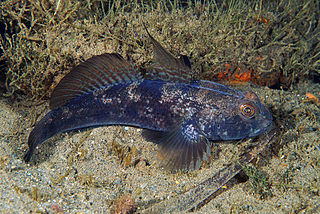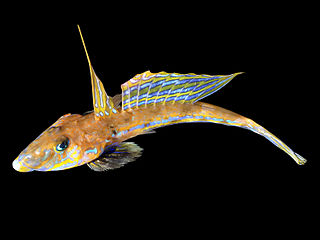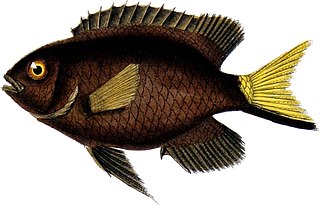
The sand goby, also known as a polewig or pollybait, is a species of ray-finned fish native to marine and brackish European waters from the Baltic Sea through the Mediterranean Sea and into the Black Sea where it occurs in sandy or muddy areas of inshore waters at depths of from 4 to 200 metres. This species can reach a length of 11 centimetres (4.3 in) TL. This species is sometimes kept in public aquariums. The sand goby is of a sandy colour, with darker markings on the sides and a creamy-white underside. In the breeding season the male fish has blue spot at the rear of the first dorsal fin, ringed with white. The fish has a slender body, and the head is about a quarter of the total length.

The grey triggerfish, or gray triggerfish, is a species of ray-finned fish in the triggerfish family Balistidae, the triggerfishes. The species is native to shallow parts of the western Atlantic from Nova Scotia to Argentina and also the eastern Atlantic, the Mediterranean Sea and off Angola on the west coast of Africa.

The black goby is a species of ray-finned fish found in the Eastern Atlantic and Mediterranean Sea and Black Sea. It inhabits estuaries, lagoons, and inshore water over seagrass and algae. It feeds on a variety of invertebrates and sometimes small fish. This species can also be found in the aquarium trade.

The sheepshead minnow, also known as sheepshead pupfish, is a species of ray-finned fish in the family Cyprinodontidae, the pupfishes. It is found in salt marsh and estuary environments and is native to the eastern coasts of North and Central America.

Stegastes variabilis, commonly known as the Brazilian cocoa damselfish, is a species of damselfish in the family Pomacentridae, found on coral reefs in the western Atlantic Ocean and off Brazil. They are often solitary fish.

Zebrasoma scopas, the brown tang, twotone tang, scopas tang or brush-tail tang, is a species of marine ray-finned fish belonging to the family Acanthuridae which includes the surgeonfishes, unicornfishes and tangs. The brown tang is found throughout Oceania and is a herbivorous fish, feeding predominantly on filamentous algae. It is a highly popular fish in the aquarium trade.

Stegastes planifrons is a damselfish from the Western Atlantic. It occasionally makes its way into the aquarium trade.

The common dragonet is a species of dragonet which is widely distributed in the eastern North Atlantic where it is common near Europe from Norway and Iceland southwards. It is a demersal species that occurs over sand bottoms. It lives to a maximum age of around seven years. It is caught in bycatch by fisheries and is used in the aquarium trade.

Hypsoblennius invemar, commonly known as the tessellated blenny, is a species of combtooth blenny found in the western Atlantic Ocean.

The seaweed blenny is a species of combtooth blenny found in coral reefs in the western Atlantic Ocean along the coasts of New York, Bermuda, the Bahamas, also in the Gulf of Mexico, south to southern Brazil. This species reaches a length of 8.5 centimetres (3.3 in) TL.

The chameleon goby is a species of ray-finned fish native to marine and brackish waters along the coasts of eastern Asia. It has also spread to other parts of the world where it is found in waters with varying degrees of salinity.
Paraclinus fasciatus, the banded blenny, is a species of labrisomid blenny native to the Atlantic Ocean including the Gulf of Mexico and the Caribbean Sea from southern Florida to Venezuela. The banded blenny is a marine organism, meaning it lives in an aquatic environment. This species lives in the vicinity of coral reefs preferring sea grass beds in shallow waters down to 2 metres (6.6 ft). Although they are typically located in shallow waters, their colors camouflage them exceptionally well, leading to them rarely being seen or recognized. They have also been found within floating algae.

Stegastes pictus, the yellowtip damselfish, is a species of damselfish found near the sea bed on shallow rocky reefs off the coast of Brazil, where it is endemic. It is a small, laterally-compressed, dark brown fish with yellow pectoral and caudal fins. It feeds on algae and detritus and is often found in the vicinity of the fire coral Millepora alcicornis. It is a territorial fish and forms a pair bond in the breeding season. The eggs are laid in a shallow scoop on the seabed and the male tends them to keep them well-aerated.

Stegastes leucostictus is a species of damselfish found near the sea bed in shallow waters on the western fringes of the Atlantic Ocean. It is commonly known as the beau gregory or beaugregory.

The roundel skate or Texas clearnose skate is a species of cartilaginous fish in the family Rajidae. It is found in the Gulf of Mexico, Southeast Florida and the Yucatan Peninsula.

The bigtooth cardinalfish or longtooth cardinalfish is a species of marine fish in the family Apogonidae and the only member of its genus. The bigtooth cardinalfish lives in the west-central Atlantic, off southern Florida, United States, and from the Bahamas to Venezuela, and as far south as Suriname. This species also is found in the east-central Atlantic and the Gulf of Guinea, and has been reported as far as Cape Verde. It is a pale orangeish colour.
Trichonotus arabicus, the Arabian sand diver, is a shallow-water, marine perciform fish in the family Trichonotidae. It is native to the western Indian Ocean, the Gulf of Oman and the Persian Gulf.

The sand steenbras or striped seabream is a species of marine fish in the family Sparidae, colloquially known as the common bastardfish for nipping at the legs of swimmers. It is found in shallow water in the Mediterranean Sea and in the eastern Atlantic Ocean from France to South Africa. It also occurs in the Red Sea and off the coast of Mozambique in the Indian Ocean. The IUCN has assessed its conservation status as being of "least concern".
The pearl blenny is a species of combtooth blenny from the subfamily Salarinae of the family Blenniidae. It occurs in shallow coastal waters in the western Atlantic Ocean. It is the type species of the genus Entomacrodus.
Gerres nigri, the Guinean striped mojarra is a species of mojarra native to the eastern Atlantic Ocean. It inhabits estuaries, coastal waters and lagoons. This species can reach a maximum length of 20 cm (8 in), with 15 cm (6 in) being a more common size.
















